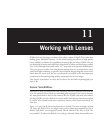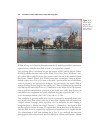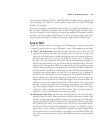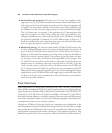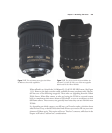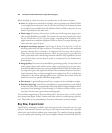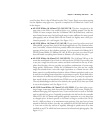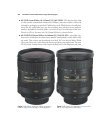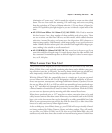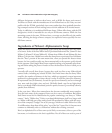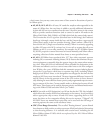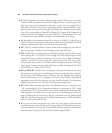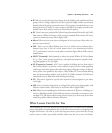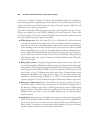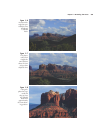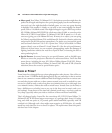
elimination of “zoom creep,” which caused the original to zoom out when tilted
down. The new lens retains the stunning 11X zoom range and covers everything
from the equivalent of 27mm to 300mm when the 1.5X crop factor is figured in,
and its VR capabilities plus light weight let you use it without a tripod most of the
time.
■ AF-S VR Zoom-Nikkor 24-120mm f/3.5-5.6G IF-ED. I felt I had to mention
this lens because I see a large number of them available used at low prices. There
are two versions, an older non-VR lens, and this model, which added vibration
reduction, internal focusing, and some extra low dispersion (ED) elements to
improve image quality. Unfortunately, while image quality is very good at the max-
imum 120mm, the lens softens quite a bit at shorter focal lengths and at larger aper-
tures, making it less suitable as an all-around tool.
■ AF-S NIKKOR 24-120mm f/4G ED VR. This newer lens is the one to get if you
want this useful focal length range. It’s much sharper than the older models, and
has a constant f/4 maximum aperture at all focal lengths. It’s also a lot more expen-
sive, at $1,100-plus.
What Lenses Can You Use?
The previous section helped you sort out what basic lens you need to buy with your
Nikon D7000. Now, you’re probably wondering what lenses can be added to your grow-
ing collection (trust me, it will grow). You need to know which lenses are suitable and,
most importantly, which lenses are fully compatible with your Nikon D7000.
With the Nikon D7000, the compatibility issue is a simple one: It can use any mod-
ern-era Nikon lens with the AF-S or AF designation, with full availability of all auto-
focus, auto aperture, autoexposure, and image-stabilization features (if present). You can
also use any Nikon AI, AI-S, or AI-P lens, which are manual focus lenses produced start-
ing in 1977 and effectively through the present day, because Nikon continues to offer
a limited number of manual focus lenses for those who need them. With the D7000,
you can even use Aperture-priority metering with older manual focus lenses.
Nikon lenses produced prior to 1977 must have a minor conversion done to be used
safely, because cameras other than certain Nikon entry-level models (such as the D3100)
have a pin on the lens mount that can be damaged by an older, unmodified lens. John
White at www.aiconversions.com will do the work for about $35 to allow these older
lenses to be safely used on any Nikon digital camera.
As far as third-party (non-Nikon) lenses go, your D7000 will accept virtually all mod-
ern lenses produced by Tokina, Tamron, Sigma, and other vendors. They will autofo-
cus just fine on a Nikon D7000, but if you also own a D40/D40x/D60, they will
autofocus only with those lenses that contain an internal focusing motor. Vendors have
Chapter 11 ■ Working with Lenses 353



